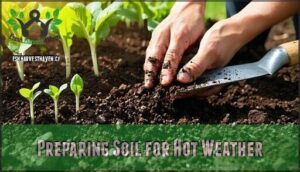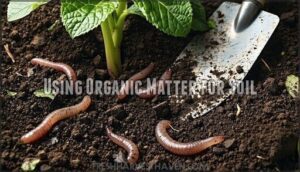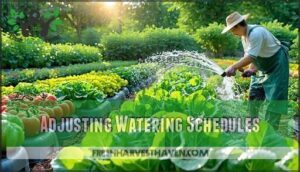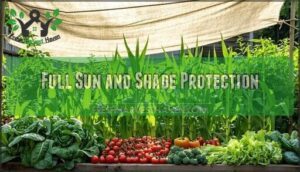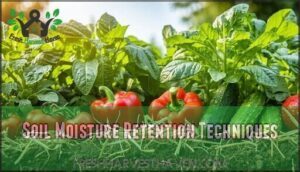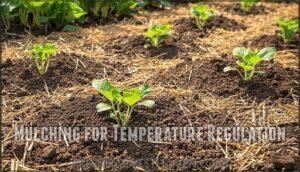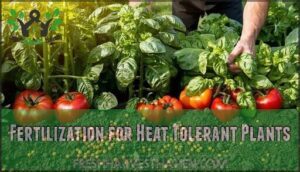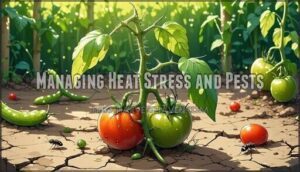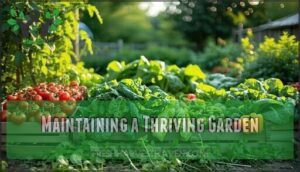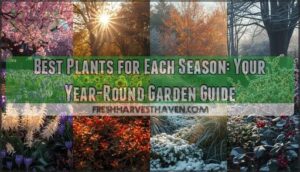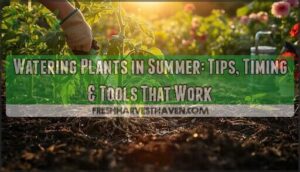This site is supported by our readers. We may earn a commission, at no cost to you, if you purchase through links.
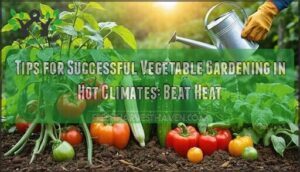
Choose heat-tolerant varieties like tomatoes, peppers, and okra that thrive in scorching temperatures.
Plant during cooler months when possible, and prepare your soil with plenty of organic matter to retain moisture.
Deep, consistent watering beats frequent shallow sprinkles – your plants’ roots need to dig deep to survive the heat.
Use mulch to keep soil cool and reduce evaporation.
Shade cloth can protect delicate seedlings from brutal afternoon sun.
Time your harvests for early morning when vegetables are crisp and full of moisture.
These fundamental strategies form the foundation for heat-resistant gardening success, using techniques like consistent watering to ensure a bountiful harvest.
Table Of Contents
- Key Takeaways
- Choosing Heat Tolerant Vegetables
- Planting in Hot Climates
- Providing Optimal Growing Conditions
- Managing Heat Stress and Pests
- Maintaining a Thriving Garden
- Frequently Asked Questions (FAQs)
- Can you grow vegetables in hot weather?
- What vegetables can you plant in a hot climate garden?
- How do you care for a hot-weather vegetable plant?
- Should you prepare your garden for the upcoming summer?
- Can you grow a garden in a hot climate?
- How do you maintain plant health in a hot climate?
- What vegetables can survive 100 degree weather?
- What temperature is too hot for a vegetable garden?
- How do I protect my vegetable garden from extreme heat?
- How hot is too hot for vegetable garden?
- Conclusion
Key Takeaways
- Choose heat-tolerant varieties – You’ll succeed by selecting vegetables like okra, peppers, and eggplants that thrive in temperatures above 95°F rather than struggling with cool-season crops
- Water deeply in the morning – You’ll maximize plant survival by watering 6 inches deep at dawn, encouraging strong root systems that can access moisture during peak heat
- Use mulch and shade protection – You’ll reduce soil temperature by 10-15°F and prevent water evaporation by applying 2-3 inches of organic mulch and using shade cloth for delicate plants
- Time your planting and harvesting strategically – You’ll boost yields by planting during cooler months when possible and harvesting in early morning hours when vegetables are crisp and full of moisture
Choosing Heat Tolerant Vegetables
When you’re gardening in hot climates, picking the right vegetables makes all the difference between a thriving garden and wilted disappointment.
Heat-tolerant varieties like okra, peppers, and eggplants can handle temperatures that would stress out cooler-weather crops, which is a key factor in achieving a thriving garden.
The right vegetable choices turn scorching heat from your garden’s enemy into your greatest ally.
Selecting Right Vegetable Varieties
Successfully choosing heat-tolerant varieties starts with understanding your growing zone and soil conditions. Solar Fire tomatoes and Ichaban eggplants exemplify cultivars bred for extreme heat resilience.
- Visit local nurseries for regionally adapted varieties and expert advice
- Research seed saving techniques to preserve successful heat-resistant genetics
- Test soil compatibility before committing to specific vegetable selections
- Focus on variety selection that matches your climate adaptation needs
- Consider heat tolerant vegetables like okra and peppers for reliable yields
Heat-resistant vegetables perform best when matched to your garden’s unique microclimate and soil type.
Considering Climate and Soil
Once you’ve chosen your vegetables, Climate Impact shapes your gardening success.
Your Soil Types determine water retention and drainage. Sandy soil drains quickly while clay holds moisture longer.
Regional Variations and Microclimates create unique growing conditions even within your yard.
| Soil Types | Drainage Needs |
|---|---|
| Sandy | Frequent watering |
| Clay | Less frequent watering |
| Loamy | Moderate watering |
Test your Soil Health and adjust Soil Fertility with organic amendments.
This Soil Preparation creates the foundation for heat-tolerant success.
Leafy Greens for Hot Weather
Green-thumbed gardeners know that leafy greens demand special attention during scorching summers.
Don’t let heat stress defeat your harvest dreams.
These heat-tolerant champions will keep your salad bowl full:
- Amaranth cultivation produces nutritious leaves that laugh at triple-digit temperatures
- Malabar spinach climbs cheerfully while regular spinach wilts and dies
- Asian greens like bok choy handle heat better than traditional lettuce varieties
- Mustard varieties actually develop better flavor in warm weather conditions
- Collard heat tolerance makes them perfect for sustained summer harvests
Smart watering techniques and shade cloth protection help these leafy greens thrive when others fail completely.
Root Vegetables for Hot Weather
Why struggle with root vegetables when sweet potatoes and carrots actually love the heat?
These heat tolerant vegetables excel with deep rooting systems that access moisture below surface level.
Your soil preparation should focus on loose, well-draining earth that allows watering depth to penetrate effectively.
Variety selection matters—choose heat-adapted cultivars that handle high soil temperature fluctuations.
Beets also offer a dual harvest, providing both roots and greens. Their nutrient needs remain steady with consistent moisture.
Master these hot climate gardening basics and you’ll harvest tender roots all season long.
Planting in Hot Climates
Successfully planting vegetables in hot climates requires careful timing and proper soil preparation to help your plants thrive despite extreme temperatures.
You’ll need to adjust your planting schedule, enhance your soil with organic matter, and modify your watering routine to create the best growing conditions possible.
Timing for Planting
Perfect timing turns your garden from surviving to thriving.
Smart timing transforms struggling plants into garden champions.
Seasonal adjustments matter—plant warm-season crops when soil reaches 60°F for proper seed germination.
Skip midsummer sowings since high temps reduce germination temperatures.
Use succession planting every 2-3 weeks to extend your harvest timing and extending growing season.
Smart avoiding frost strategies and staggered sowings boost yields substantially.
Preparing Soil for Hot Weather
Setting up your soil properly makes all the difference in hot weather gardening. Start by working in soil amendments like compost to boost water retention and drainage solutions for ideal root health.
Consider purchasing compost materials to enhance your soil.
- Soil amendments: Mix compost or aged manure into existing soil for better structure
- pH balance: Test and adjust soil to 6.0-7.0 range for nutrient uptake
- Mulch types: Apply organic mulch around plants to regulate temperature
Proper soil preparation creates the foundation your heat-tolerant vegetables need to thrive during scorching summer days.
Using Organic Matter for Soil
Once you’ve set up your soil’s foundation, organic matter becomes your garden’s best friend. Compost Benefits include improved Soil Structure and enhanced Water Retention for hot climates.
| Organic Matter Type | Soil Health Benefits | Application Method |
|---|---|---|
| Compost | Nutrient Release, Microbial Life | Mix during soil preparation |
| Manure | Soil enrichment, structure | Work into existing soil |
| Leaf mold | Water retention, aeration | Top-dress around plants |
| Worm castings | Slow nutrient release | Blend with potting mix |
This soil preparation step feeds beneficial Microbial Life that keeps plants thriving in extreme heat. Conservation tillage methods reduce soil disturbance and improve water infiltration.
Adjusting Watering Schedules
Smart watering frequency makes all the difference in hot climates.
You’ll want to water deeply each morning, reaching 6 inches down to encourage strong roots.
Here’s your game plan:
- Morning watering beats evaporation and keeps plants hydrated all day
- Drip irrigation delivers water directly to roots without waste
- Rainwater harvesting supplements your watering techniques naturally
Deep watering twice weekly trumps daily shallow sprinkling for better soil moisture retention.
Providing Optimal Growing Conditions
Creating the right growing conditions helps your vegetables thrive even when temperatures soar. You’ll need to balance sun exposure with protection while managing soil moisture and nutrients effectively.
Full Sun and Shade Protection
After proper soil preparation, you’ll need to balance sunlight needs with shade structures for ideal growth.
Shade cloth provides 30-50% coverage, preventing sunburn while maintaining adequate light.
Strategic plant placement creates natural protection—tall crops like corn shield smaller greens from harsh afternoon sun.
| Shade Method | Coverage % | Best For |
|---|---|---|
| Shade cloth | 30-50% | Leafy greens, herbs |
| Tall companion plants | Variable | Tomatoes, peppers |
| Temporary structures | 40-70% | Seedlings, transplants |
| Natural windbreaks | 20-30% | Root vegetables |
Leaf protection prevents heat damage during peak hours.
Sun protection plants thrive with morning sun and afternoon shade, maximizing photosynthesis while avoiding stress.
Soil Moisture Retention Techniques
Beyond providing adequate shade, your plants need consistent hydration to survive scorching temperatures.
Maintaining steady soil moisture requires strategic planning.
Here’s how to keep your garden hydrated:
- Install drip irrigation systems for precise water retention and reduced evaporation reduction
- Apply mulch around plants using organic mulch types like straw or wood chips for soil cooling
- Add soil amendments such as compost to improve water-holding capacity
- Implement water harvesting techniques like rain barrels to supplement irrigation needs
These methods work together to create a moisture-rich environment that supports healthy plant growth even during extreme heat waves.
Many gardeners find success with complete irrigation kits.
Mulching for Temperature Regulation
Good soil moisture sets the stage for mulch gardening success.
Mulch materials like straw or wood chips create a protective barrier that drops soil temperature by 10-15°F.
Apply 2-3 inches for best water retention and weed suppression.
To guarantee proper drainage and planting ease, remember to level your garden beds.
This natural temperature management system transforms your garden into a cool oasis.
| Mulch Materials | Soil Cooling Effect | Water Retention | Weed Suppression | Mulch Depth |
|---|---|---|---|---|
| Straw | Excellent | High | Very Good | 2-3 inches |
| Wood chips | Good | Medium | Excellent | 2-4 inches |
| Shredded leaves | Good | High | Good | 2-3 inches |
| Grass clippings | Fair | Medium | Fair | 1-2 inches |
| Compost | Fair | Very High | Poor | 1-2 inches |
Fertilization for Heat Tolerant Plants
While mulch protects roots, proper fertilization fuels heat-tolerant vegetable growth.
Test your soil first to identify nutrient deficiency and deficiency symptoms.
Choose slow-release organic fertilizers like compost that won’t burn plants in extreme heat.
Time application timing for early morning or evening when temperatures drop.
Balance nutrient needs with appropriate fertilizer types while maintaining ideal soil pH and soil structure.
Managing Heat Stress and Pests
High temperatures and hungry pests can quickly turn your garden dreams into a nightmare.
You’ll need to watch for wilting leaves and yellowing plants while protecting your vegetables from insects that thrive in hot weather.
Monitoring for Signs of Heat Stress
Since your plants can’t speak up when they’re struggling, you’ll need to watch for telltale signs of heat stress.
Here’s what to look for:
- Wilting Leaves: Drooping foliage signals dehydration or overheating—check soil moisture immediately.
- Sunscald: Yellow or white patches on fruits indicate sunburn damage.
- Blossom Drop: Flowers falling off means temperatures are too high for proper fruit set.
Additional warning signs include leaf curling and stunted growth, which both indicate your plants need relief from extreme heat.
Protecting Young Plants From Pests
Young plants need protection from pests that thrive in hot weather.
Beneficial insects like ladybugs provide natural pest control, while companion planting with marigolds deters harmful bugs.
Use shade cloth gardening and pest barriers to shield vulnerable seedlings.
Trap cropping draws pests away from main plants.
Apply organic sprays early when you spot threats.
Consistent monitoring prevents major infestations during heat stress periods.
Using Row Covers and Soil Care
Through strategic placement of row covers, you’ll protect plants from intense heat while maintaining airflow.
Row Cover Types include lightweight fabrics and shade cloth for different protection levels.
Soil Temperature Control improves with proper mulching and organic matter additions.
These soil preparation techniques enhance Moisture Management by retaining water longer.
Pest Exclusion becomes easier when covers create barriers against harmful insects.
Consider different cover options for ideal plant protection.
Combined soil amendments offer lasting benefits for your garden’s resilience, and improve overall Soil Temperature Control and Pest Exclusion through Row Cover Types.
Organic Pest Control Methods
Row covers protect your plants, but beneficial insects and natural pest control methods form your next defense line.
Companion planting with basil and marigolds repels pests naturally.
Apply neem oil for stubborn infestations, while diatomaceous earth controls crawling insects.
Set up pest traps for monitoring and early detection.
These organic fungicides and techniques keep your garden healthy without harsh chemicals during hot weather challenges.
Maintaining a Thriving Garden
You’ve achieved success with your heat-tolerant vegetables, but maintaining that thriving garden requires ongoing attention to harvesting, storage, and technique refinement.
Perfect timing for harvest and proper storage methods will keep your hard-earned produce fresh while you continue learning which varieties work best in your specific climate.
Harvesting at Right Time
Harvesting Morning brings cooler temperatures and peak flavors to your vegetable garden. Time your harvest right to avoid heat damage and maximize taste.
Here’s your roadmap to prompt harvesting success:
- Check for color changes and firm textures
- Harvest before 10 AM when sugar levels peak
- Handle produce gently to prevent bruising
- Move vegetables to shade immediately after picking
Timing for Flavor matters more than you think. Avoiding Heat Damage keeps your harvest fresh and extends storage life.
These harvesting techniques guarantee your vegetable gardening efforts pay off in hot climates.
Storing Vegetables for Freshness
Your fresh harvest deserves proper care to maximize shelf life and maintain quality.
Smart storage techniques prevent spoilage and extend freshness for weeks.
- Cool immediately – Wash vegetables with cool water to remove field heat and contaminants
- Control humidity – Use perforated storage containers for leafy greens at 95% humidity
- Separate ethylene gas producers – Keep tomatoes away from ethylene-sensitive crops
- Maintain ideal temperatures – Store at 32-36°F for greens, 55-70°F for tomatoes
- Consider blanching vegetables – Vacuum-seal blanched produce to double refrigerated shelf life
Learning About Heat Resistant Vegetables
Understanding your garden’s climate adaptation needs helps you choose the right heat-resistant varieties for success.
Heat-tolerant vegetables like okra, Malabar spinach, and sweet potatoes offer unique nutritional value while thriving in tough conditions.
Research heat-resistant traits in warmseason crops to match your growing techniques with drought resistant crops that’ll flourish despite challenging weather.
Adjusting Gardening Techniques for Success
Success in gardening in hot climates requires smart adjustments to your techniques.
Microclimate management helps you create cooler spots using shade structures and strategic plant placement. Vertical gardening and container gardening maximize space while improving air circulation.
Hydroponics and aquaponics systems reduce water waste and heat stress. Fine-tune your watering techniques by checking soil moisture daily and adjusting schedules based on weather patterns.
Proper soil preparation with organic matter improves heat tolerance, while targeted pest control keeps your heat-tolerant vegetables healthy throughout the growing season.
Employing drip irrigation systems can also substantially reduce water waste.
Frequently Asked Questions (FAQs)
Can you grow vegetables in hot weather?
Heat-adapted tomatoes show 25-40% higher fruit set during 90-100°F days.
You can absolutely grow vegetables in hot weather by choosing heat-tolerant varieties like okra, peppers, and eggplants that thrive in extreme temperatures.
What vegetables can you plant in a hot climate garden?
You can grow tomatoes like Solar Fire, peppers including jalapeños and habaneros, eggplants, okra, summer squash, cucumbers, sweet potatoes, and heat-tolerant herbs like rosemary and thyme.
How do you care for a hot-weather vegetable plant?
Water deeply in the morning, mulch around plants to retain moisture, and harvest during cooler hours. Monitor soil moisture regularly and adjust watering based on weather conditions.
Should you prepare your garden for the upcoming summer?
Like a smart farmer who sharpens tools before harvest season, you’ll want to prep your garden now.
Start soil amendments, install drip irrigation, and plant heat-tolerant varieties before summer’s peak intensity hits your crops.
Can you grow a garden in a hot climate?
You can definitely grow a successful garden in hot climates by choosing heat-tolerant varieties like okra, peppers, and eggplants, providing proper water management, and timing your plantings strategically.
How do you maintain plant health in a hot climate?
Under the scorching sun’s relentless gaze, you’ll need to shield your green warriors from heat stress.
Water deeply at dawn, mulch heavily, and choose heat-tolerant varieties like okra and peppers that laugh at high temperatures.
What vegetables can survive 100 degree weather?
Eggplants, okra, and cucumbers thrive in 100°F heat.
Heat-tolerant tomato varieties like ‘Heatmaster‘ and ‘Solar Fire‘ handle extreme temperatures.
Peppers, including jalapeños and habaneros, also survive scorching conditions with proper care.
What temperature is too hot for a vegetable garden?
When temperatures climb above 95°F, most vegetable gardens start struggling.
Your plants wilt and stop producing fruit when heat becomes their enemy.
Even heat-tolerant varieties like tomatoes and peppers suffer when temperatures consistently exceed 95-100°F during the day.
How do I protect my vegetable garden from extreme heat?
Use shade cloth, mulch heavily, water deeply in mornings, and choose heat-tolerant varieties like okra and peppers. Install drip irrigation and harvest during cooler hours to minimize stress.
How hot is too hot for vegetable garden?
Most vegetables struggle when temperatures consistently exceed 95°F, with tomato fruit set dropping 25-40% during 90-100°F days.
You’ll need heat-tolerant varieties like okra, peppers, and eggplants for sustained success above this threshold.
Conclusion
Like a well-oiled machine, your garden will flourish with proper care and attention.
These tips for successful vegetable gardening in hot climates will transform your growing space into a productive oasis. You’ll discover that selecting heat-tolerant varieties, timing your planting correctly, and maintaining consistent watering schedules make all the difference.
Remember to mulch heavily, provide adequate shade protection, and harvest during cooler morning hours.
With patience and these proven techniques, you’ll enjoy fresh vegetables throughout the hottest months of the year.


